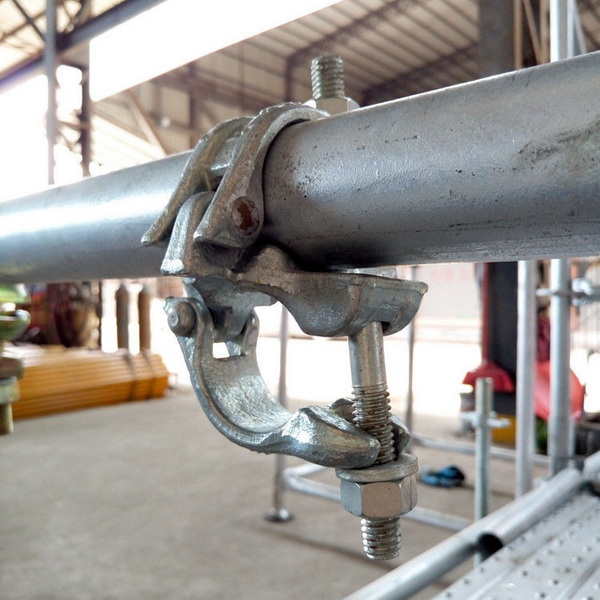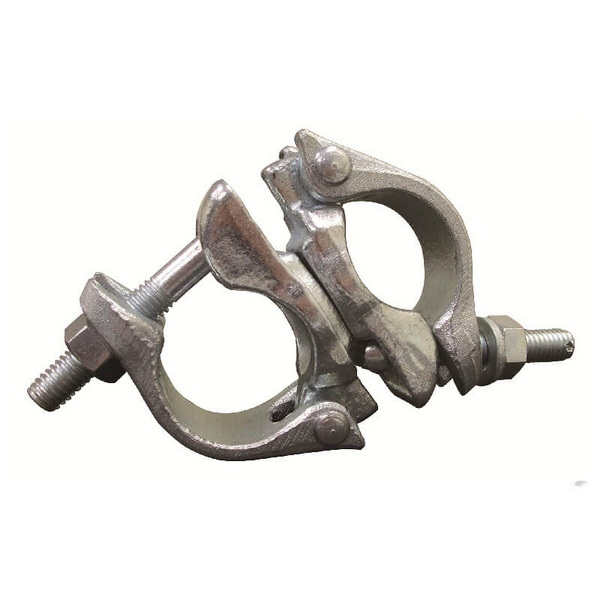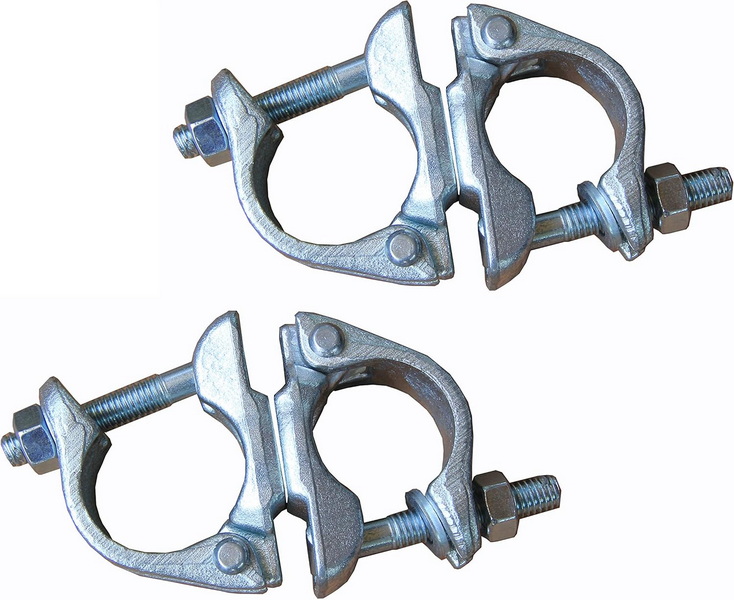Content Menu
● What Is a Scaffolding Clamp Swivel Type?
● Components of a Swivel Clamp
● How Does a Scaffolding Clamp Swivel Type Work?
● Why Use a Scaffolding Clamp Swivel Type?
>> 1. Flexibility in Scaffold Design
>> 2. Adaptability to Non-Standard Angles
>> 3. Enhanced Structural Stability
>> 4. Time Efficiency
● Types of Scaffolding Clamp Swivel Types
>> Standard Swivel Couplers
>> Heavy-Duty Swivel Couplers
>> Press-Fit Swivel Couplers
>> Double Coupler Swivel Clamps
● Common Applications of Scaffolding Clamp Swivel Type
>> Construction Sites
>> Industrial Maintenance
>> Bridge and Infrastructure Projects
>> Event Staging and Temporary Structures
● Technical Specifications and Load Capacity
● Safety and Compliance
● Advantages of Using Scaffolding Clamp Swivel Type
● Installation Tips for Scaffolding Clamp Swivel Type
● Maintenance and Inspection Tips
● Conclusion
● FAQ
>> 1. What is the primary function of a scaffolding clamp swivel type?
>> 2. How does a swivel clamp differ from a right-angle clamp?
>> 3. Are swivel clamps strong enough for heavy-duty scaffolding?
>> 4. What materials are scaffolding clamp swivel types made from?
>> 5. How should swivel clamps be maintained to ensure safety?
Scaffolding clamp swivel type, commonly referred to as swivel clamps or swivel couplers, is an essential component in scaffolding construction. These clamps enable the secure connection of two scaffold tubes at various angles, providing flexibility and adaptability to scaffolding structures. This article explores the purpose, design, applications, types, safety considerations, maintenance, and advantages of the scaffolding clamp swivel type.

What Is a Scaffolding Clamp Swivel Type?
A scaffolding clamp swivel type is a mechanical device used to join two scaffold tubes at any angle, unlike fixed right-angle clamps which only connect tubes at 90 degrees. The swivel clamp consists of two clamp halves connected by a bolt and nut, allowing one clamp to rotate relative to the other. This rotation permits the tubes to be positioned at various angles, accommodating complex scaffold geometries.
Components of a Swivel Clamp
- Forged Steel Body: Provides strength and durability.
- Two Forged Steel Caps: Secure the tubes firmly.
- Bolt and Nut Assembly: Enables swivel action and locking at desired angles.
- Washers: Reduce friction and prevent galling during tightening.
How Does a Scaffolding Clamp Swivel Type Work?
The swivel clamp connects two tubes by encircling each with a clamp half. The bolt and nut assembly between the clamps allow rotation before tightening. Once the tubes are positioned at the required angle, the clamp is securely fastened, locking the tubes in place. This design offers both flexibility during assembly and rigid stability once installed.
Why Use a Scaffolding Clamp Swivel Type?
1. Flexibility in Scaffold Design
Swivel clamps allow scaffold builders to create structures that conform to irregular shapes, slopes, or curved surfaces. This flexibility is crucial in construction sites with complex architectural features or uneven terrain.
2. Adaptability to Non-Standard Angles
Unlike right-angle clamps, swivel clamps enable connections at any angle, making them indispensable for diagonal bracing and non-orthogonal scaffold configurations.
3. Enhanced Structural Stability
By enabling diagonal bracing at adjustable angles, swivel clamps increase the overall rigidity and safety of scaffolding structures.
4. Time Efficiency
Swivel clamps simplify assembly by allowing quick adjustments without the need for precise pre-cut tubes or fixed-angle fittings.
Types of Scaffolding Clamp Swivel Types
Standard Swivel Couplers
- Used for general scaffolding applications.
- Allow connection at any angle.
- Typically forged steel with bolt and nut tightening.
Heavy-Duty Swivel Couplers
- Designed for larger scaffolding systems or higher load requirements.
- Made from stronger materials to withstand greater stress.
- Suitable for industrial or large-scale construction projects.
Press-Fit Swivel Couplers
- Utilize a press-fit mechanism instead of bolts.
- Allow faster assembly and disassembly.
- Provide strong joints with less manual tightening.
Double Coupler Swivel Clamps
- Feature two swivel clamps combined for extra strength.
- Used in heavy-duty or complex scaffolding configurations.

Common Applications of Scaffolding Clamp Swivel Type
Construction Sites
Swivel clamps are used extensively to build scaffolds around irregular building shapes, sloping roofs, and curved facades.
Industrial Maintenance
In oil refineries, power plants, and factories, swivel clamps enable scaffolding to adapt to complex piping and machinery layouts.
Bridge and Infrastructure Projects
Swivel clamps facilitate scaffolding on bridges and tunnels where angles vary significantly.
Event Staging and Temporary Structures
The flexibility of swivel clamps supports customized scaffolding for stages, platforms, and exhibition setups.
Technical Specifications and Load Capacity
- Tube Diameter Compatibility: Most swivel clamps fit standard scaffold tubes with outer diameters of 48.3 mm.
- Load Capacity: Swivel clamps can bear loads exceeding 20 kN (kilonewtons), depending on the class (EN 74 Class A or B).
- Material: Typically forged steel with galvanization or electroplated finishes for corrosion resistance.
- Weight: Usually between 1.7 to 2 kg per clamp, depending on design.
Safety and Compliance
Swivel clamps must comply with international standards such as:
- EN 74: European standard for couplers.
- OSHA: Occupational Safety and Health Administration regulations.
- ANSI: American National Standards Institute guidelines.
Proper installation and regular inspection are critical to maintaining scaffold safety. Clamps should be tightened to manufacturer specifications to prevent slippage or joint failure.
Advantages of Using Scaffolding Clamp Swivel Type
| Advantage | Description |
| Flexibility | Connect tubes at any angle for complex scaffold designs. |
| Versatility | Suitable for diagonal bracing and non-orthogonal connections. |
| Strength | High load-bearing capacity ensures scaffold stability. |
| Ease of Use | Simple bolt and nut mechanism for quick assembly. |
| Durability | Forged steel construction resists wear and corrosion. |
| Reusability | Can be dismantled and reused multiple times. |
Installation Tips for Scaffolding Clamp Swivel Type
- Correct Tube Positioning: Before tightening, ensure tubes are correctly aligned at the desired angle.
- Tightening Torque: Use torque wrenches where possible to achieve manufacturer-recommended tightness.
- Avoid Over-tightening: Excessive force can damage clamps or tubes.
- Use Anti-Seize Lubricants: Apply on bolts to prevent corrosion and ease future disassembly.
- Regular Checks: Inspect clamps periodically during use for loosening or damage.
Maintenance and Inspection Tips
- Regular Inspection: Check clamps for wear, corrosion, and damage before each use.
- Lubrication: Apply anti-seize lubricant to bolts to prevent galling.
- Tightening: Ensure bolts are tightened to the recommended torque.
- Storage: Keep clamps in a dry, clean environment to prevent rust.
- Replacement: Replace any clamps showing cracks, deformation, or excessive wear.
Conclusion
The scaffolding clamp swivel type is an indispensable component in modern scaffolding systems, providing unparalleled flexibility and strength. Its ability to connect tubes at any angle makes it ideal for complex, irregular, or sloped scaffolding structures commonly found in construction, industrial maintenance, and infrastructure projects. With high load-bearing capacity and compliance with international safety standards, swivel clamps ensure safe and adaptable scaffolding assemblies. Proper installation, maintenance, and inspection further enhance their reliability, making swivel clamps a preferred choice for professionals worldwide.

FAQ
1. What is the primary function of a scaffolding clamp swivel type?
The primary function is to connect two scaffold tubes at any angle, allowing for flexible and adaptable scaffold configurations.
2. How does a swivel clamp differ from a right-angle clamp?
A swivel clamp can connect tubes at any angle, while a right-angle clamp only connects tubes at 90 degrees.
3. Are swivel clamps strong enough for heavy-duty scaffolding?
Yes, especially heavy-duty swivel clamps are designed to withstand high loads and stresses typical in industrial and construction environments.
4. What materials are scaffolding clamp swivel types made from?
They are typically made from forged steel with galvanization or electroplated finishes to resist corrosion.
5. How should swivel clamps be maintained to ensure safety?
Regular inspection for damage, proper tightening of bolts, lubrication to prevent galling, and replacement of worn parts are essential maintenance practices.






















